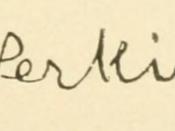"The Yellow Wallpaper", a short story by Charlotte Perkins Gilman is the disheartening tale of a woman suffering from postpartum depression. Set during the late 1890s, the story shows the mental and emotional results of the typical "rest cure" prescribed during that era and the narrator's reaction to this course of treatment. It would appear that Gilman was writing about her own anguish as she herself underwent such a treatment with Dr. Silas Weir Mitchell in 1887, just two years after the birth of her daughter Katherine. The rest cure that the narrator in "The Yellow Wallpaper" describes is very close to what Gilman herself experienced; therefore, the story can be read as reflecting the feelings of women like herself who suffered through such treatments. Because of her experience with the rest cure, it can even be said that Gilman based the narrator in "The Yellow Wallpaper" loosely on herself.
Throughout the plot of "The Yellow Wallpaper" there are many instances that show that the narrator was based upon Charlotte Perkins Gilman views on her own life.
The two common themes that connect Charlotte Perkins Gilman and the narrator in her story are postpartum depression and entrapment within their roles as women in the late 1800s society. After fulfilling their expected duties as wife and mother, both Gilman and the narrator become depressed after the birth of their child. It is this depression that leads them to the infamous rest cure so widely prescribed during the late 1800's. Linda Wagner-Martin, in her essay on "The Yellow Wallpaper" describes Dr. Mitchell'streatment of the typical female seeking his world famous rest cure. Wagner-Martin states that the rest cure "depended upon seclusion, massage, immobility, and overfeeding; . . .
[it] had at its...


